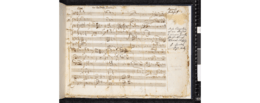Adagio and Rondo for glass harmonica, flute, oboe, viola and cello

The Adagio and Rondo, K. 617, is a quintet composed by Wolfgang Amadeus Mozart for glass harmonica, flute, oboe, viola and cello.[1] Completed on May 23, 1791 (the date indicated in Mozart's own list of his works[2]), it was written for Marianne Kirchgessner, a blind glass harmonica virtuoso, who played the first performance in the Burgtheater Akademie on June 10, 1791, and subsequently performed it at the Kärtnertortheater on August 19, 1791.[1]
The autograph manuscript is in the British Library as part of the Stefan Zweig Collection. It was purchased by Zweig from a Berlin auction house in 1930.[3]
The work was first published by Breitkopf & Härtel in 1799.[1]
The adagio, in C minor, is 58 bars long, while the rondo (C major) contains 230 bars.[1]
References
- 1 2 3 4 Köchel 1964, p. 703.
- ↑ Federhofer 1957, p. 79.
- ↑ British Library website, accessed 15 October 2015
Sources
- Köchel, Ludwig Ritter von Köchel (1964). Chronologisch-thematisches Verzeichnis sämtlicher Tonwerke Wolfgang Amadé Mozarts : nebst Angabe der verlorengegangenen, angefangenen, von fremder Hand bearbeiteten, zweifelhaften und unterschobenen Kompositionen. Wiesbaden: Breitkopf & Härtel. pp. 703–704.
- Federhofer, Hellmut (1957). Kritsche Bericht: Quintette, Quartette und Trios mit Klavier und mit Glasharmonika. Serie VII, Werkgruppe 22, Abteilung 1. Kassel: Bärenreiter. pp. 79–82.
External links
- Adagio and Rondo for Glass Harmonica, Flute, Oboe, Viola and Cello: Scores at the International Music Score Library Project
- Adagio and Rondo for glass harmonica, flute, oboe, viola and cello: Score in the Neue Mozart-Ausgabe
- Zweig MS 61 (digitized manuscript from the British Library)
- Adagio and Rondo in C, K.617 on YouTube